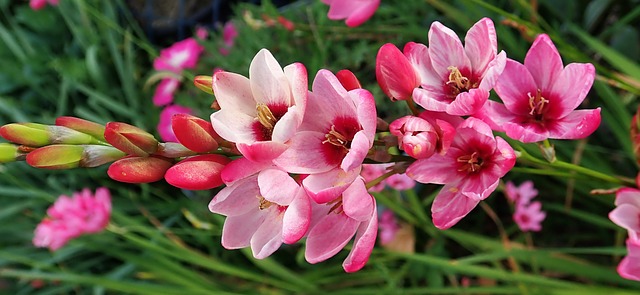With its vibrant colors and unique corn-like flowers, the African corn lily captivates gardeners and plant lovers around the world. But what are the origins of this visually striking bloom? Let’s trace the botanical history of the African corn lily to learn more about this floral beauty.
The African corn lily, known scientifically as Ixia, belongs to the iris family Iridaceae. There are around 50 different Ixia species, all native to South Africa. These plants are characterized by long, sword-shaped leaves and colorful flowers that bloom in spikes resembling corncobs, hence the common name “corn lily.”
The blooms showcase a diversity of hues, ranging from magenta and violet to yellow and white Their shapely flowers have six petals fanning out from a central cup, creating a starburst effect When in full bloom, African corn lilies put on an eye-catching floral display.
The Cape Floral Kingdom: Cradle of the African Corn Lily
To understand the origins of the African corn lily, we must look to the Cape Floral Kingdom in South Africa. This biodiversity hotspot is home to over 9,000 plant species, making it one of the richest regions for flora in the world.
The Cape Floral Kingdom claims the African corn lily as one of its native botanical wonders. The diverse landscape, with its mountains, coastal plains, and lush valleys, provides ideal growing conditions for Ixia species.
The winter rainfall, nutrient-rich soil, and Mediterranean climate allows the African corn lily to prosper and evolve impressive adaptability. They thrive across varying environments within the Cape Floral Kingdom.
Cultural Significance as a Symbol of Hope and Renewal
Beyond its visual appeal, the African corn lily holds deep cultural meaning for native tribes in South Africa. Its seasonal blooming cycle coincides with the harvest period. The vibrant spikes symbolize prosperity, hope, and bounty.
According to African folklore, the African corn lily represents themes of rebirth and renewal. It inspires stories of resilience, with its ability to withstand drought and bloom in difficult conditions. The flower is often incorporated into cultural ceremonies.
While the African corn lily originated in South Africa, its mesmerizing flowers have earned it admirers around the world. During the 18th century, early horticulturists brought Ixia species to Europe as ornamental plants.
Thanks to its hardiness, vibrant colors, and extended blooming period, the African corn lily quickly became a cherished garden flower. Today, it is cultivated across Europe, Australia, and North America.
Modern breeders have introduced cultivars in diverse shades and patterns, furthering its appeal as a garden showstopper. It attracts pollinators, adding ecological value.
The Need for Conservation of a Beloved Flower
Despite the global adoration for African corn lilies, these iconic flowers face threats in their native habitat. Urbanization, climate change, and agricultural expansion have led to habitat loss across South Africa.
Several conservation organizations are striving to protect the biodiversity of the Cape Floral Kingdom, including its treasured corn lilies. They aim to preserve genetic diversity by seed banking, restore degraded habitats, and spread awareness.
Gardeners worldwide can also play a role by cultivating pollinator-friendly African corn lilies. As stewards of nature, we must recognize the need to conserve the Cape’s botanical wonders for future generations.
Celebrating South Africa’s Floral Heritage
The vibrant African corn lily exemplifies the rich biodiversity of South Africa’s plant life. As one of over 9,000 floral species native to the Cape Floral Kingdom, the Ixia holds an important place in the region’s ecological heritage.
Beyond its visual brilliance, the African corn lily carries significant cultural symbolism. Its story speaks of hope and rebirth – a message that continues to inspire people across the globe. By honoring its heritage, we celebrate the resilience and splendor of nature’s marvels.

k
How to plant a pot of Ixia (corn lily)
FAQ
Where does the African lily flower come from?
What does the Ixia flower symbolize?
What is the origin of a lily?
What is the vase life of African corn lilies?
Are African corn lilies perennials?
A South African native, Ixia plant info indicates African corn lily plants are short-lived perennials and may perform as annuals, not returning after a hard winter. However, Ixia wand flower corms are readily available in garden centers and big box stores and are usually not expensive, so replanting is not much of a chore.
What is a corn lily?
Some of them are known as the corn lily. Some distinctive traits include sword-like leaves and long wiry stems with star-shaped flowers. It usually prefers well-drained soil. The popular corn lily has specific, not very intense fragrance. It is often visited by many insects such as bees. The Ixia are also used sometimes as ornamental plants.
How to propagate African corn lily?
The propagation of this plant is also done through seeds; however, it might take three years or more for them to bloom. The Ixia flower seeds should be covered with soil once the last spring frost has passed. The African corn lily also propagates naturally through insects and bees.
What does a corn lily look like?
This showy “Corn Lily” is actually in the Iris family and native to South Africa’s Cape Province. The yellow and orange-yellow flowers are star-shaped of 6 petals up to 2.5 inches. Leaves are long and sword-like while10-20 inch wiry stems hold the clusters of flowers.
